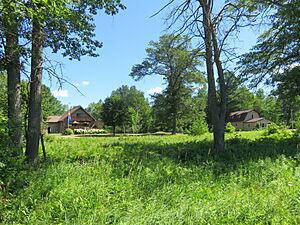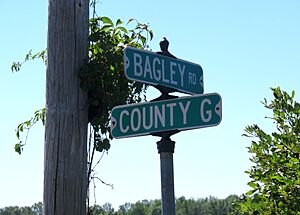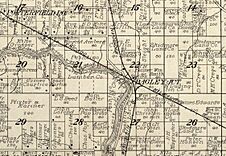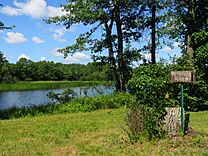Bagley Junction, Wisconsin facts for kids
Quick facts for kids
Bagley Junction, Wisconsin
|
|
|---|---|
 |
|
| Country | |
| State | |
| County | Marinette |
| Elevation | 190 m (630 ft) |
| Time zone | UTC-6 (Central (CST)) |
| • Summer (DST) | UTC-5 (CDT) |
| Area codes | 715 & 534 |
| GNIS feature ID | 1577500 |
Bagley Junction is a small, quiet place in Marinette County, Wisconsin, United States. It's called an unincorporated community, which means it's a group of homes and buildings that isn't officially a town or city with its own local government. It's part of the larger town of Porterfield.
Contents
Exploring Bagley Junction's Location
Bagley Junction is found on Bagley Road. It sits right next to the Peshtigo River, which flows into the Potato Rapids Reservoir. This area is about 630 feet (192 meters) above sea level.
You can reach Bagley Junction by road from several nearby places. These include Walsh to the north and Porterfield to the west. You can also get there from Peshtigo to the south and Marinette to the east.
How Bagley Junction Got Its Name

Both Bagley Junction and Bagley Road are named after a man named John Bagley. He was born in Quebec on June 20, 1852. John Bagley was a very active lumberman, which means he worked in the timber industry.
He first worked in Wisconsin. Later, he moved to Washington and became the president of the Tacoma Eastern Railroad. He passed away on August 17, 1920, in Tacoma, Washington. Interestingly, there's another place called Bagley Junction in King County, Washington, also named after him!
A Look at Bagley Junction's Past
Long before white settlers arrived, Native Americans lived in the area that is now Bagley Junction. In 1913, a researcher named Harvey O. Younger found four oval-shaped burial mounds here. These mounds are like small hills where people were buried. He also found a stone hoe, a tool used for farming.
The soil in these mounds came from the bank of the Peshtigo River. Experts believe these mounds might be from the Late Woodland period, which was between 500 and 1000 CE. In 2007, more studies were done on these mounds for a road project. They found two mounds, about 75 feet apart, near Bagley Road and the Peshtigo River. The other two mounds found in 1913 are thought to have been destroyed by an old driveway.
Railroad History
In 1894, the Wisconsin & Michigan Railway opened an office and workshops in Bagley Junction. They hired up to sixty men and built coal sheds and water tanks. From 1894 to 1938, Bagley Junction was an important spot for trains. It was a railroad junction, meaning different train lines met there.
One line went north to Walsh and then to Iron Mountain, Michigan. This track was actually built using extra rails from the Chicago World's Fair, which had ended in 1893. The line to Walsh was removed in 1938. However, an east-west train track that used to belong to the Milwaukee Road still exists today. This track is now owned by the Escanaba and Lake Superior Railroad.
Life in the Early 1900s
In the early 1900s, Bagley Junction had a lumber camp and a sawmill. A lumber camp is where loggers lived and worked. They would cut down trees, and the sawmill would turn the logs into lumber.
In the 1920s, a man named Andrew Jackson Smith lived in Bagley Junction. He was a veteran of the Civil War. People jokingly called him the "mayor" of Bagley Junction.
As of 2010, Bagley Junction had three houses. That same year, it was also the location for the USCA National Canoe and Kayak Championships, a big event for canoeing and kayaking!






